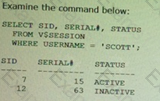Identify two solutions that Oracle provides for patch conflict.
Identify three types of important statistics collection that you can disable in Oracle Database 12c by setting the STATISTIS_LEVEL parameter to BASIC.
Which database feature can be used for organizing data when there is a very large amount of data?
Which two statements are true about listeners?
What new role in Oracle Database 12c encompasses the administrative privileges required for backup and recovery?
Which statement is true regarding this connect string?
(DESCRIPTION
(FAILOVER=on)
(ADDRESS_LIST=
(LOAD_BALANCE=ON)
(ADDRESS=(host=sales-east1) (port=1522) )
(ADDRESS=(host=sales-east2)(port=1522))
(ADDRESS=(host=sales-east3) (port=1522) ))
(ADDRESS_LIST=
(LOAD_BALANCE=ON)
(ADDRESS=(host=sales-west1) (port=1522) )
(ADDRESS=(host=sales-west2) (port=JS22))
(ADDRESS=(host=sales-west3) (port=lS22) ) )
(CONNECT_DATA=
(SERVICE_NAME=sales)
(REGION=east)))
Examine the error:
GSM-45054: GSM error or NET-40006: unable to start GSH
What is the cause of this error, and what troubleshooting steps should you perform?
YOU want to move all objects of the CONSULTANT user from the test database to theDB-USER schema of the production database. Which option of IMPDP would you use to accomplish this task?
For which use case would you use a rolling upgrade with the Oracle Active Data Guard feature?
Your customer needs server availability that provides uninterrupted access to database services, handling any unexpected failure of one or more machines hosting the database server, due to a hardware or software fault. Which product should your customer use?
Which two statements are true about transactions in Oracle Database 12c?
Examine the command:
SQL> CREATE TABLE orders(oid NUMBER (6) PRIMARY KEY, odato DATE, ccode NUMBER (6), oamt NUMBER (10, 2)) TABLESPACE users ;
Which two statements are true about the execution of the command?
A standby database is in mounted state and you are required to perform a failover to the physical standby. Which solution is best suited forthis scenario?
Examine the command:
sqlplus /nolog
In which scenario would this command execute successfully?
Which statement about Oracle patches is false?
Which two statements about multitenant architecture are true?
Your customer is looking for zero-data-loss failover with maximum data protection and high availability for their primary database. Which two solutions would you recommend to the customer if the distance between the primary and the standby location is more than 300 miles?
Which two statements represent where Oracle Net must reside?
An Oracle instance is a combination of______.
Which two statements about Automatic Data Optimization (ADO) are true?
Which three tasks can you perform in Database Express?
Exhibit below:

Which three statements are true about terminating a session?